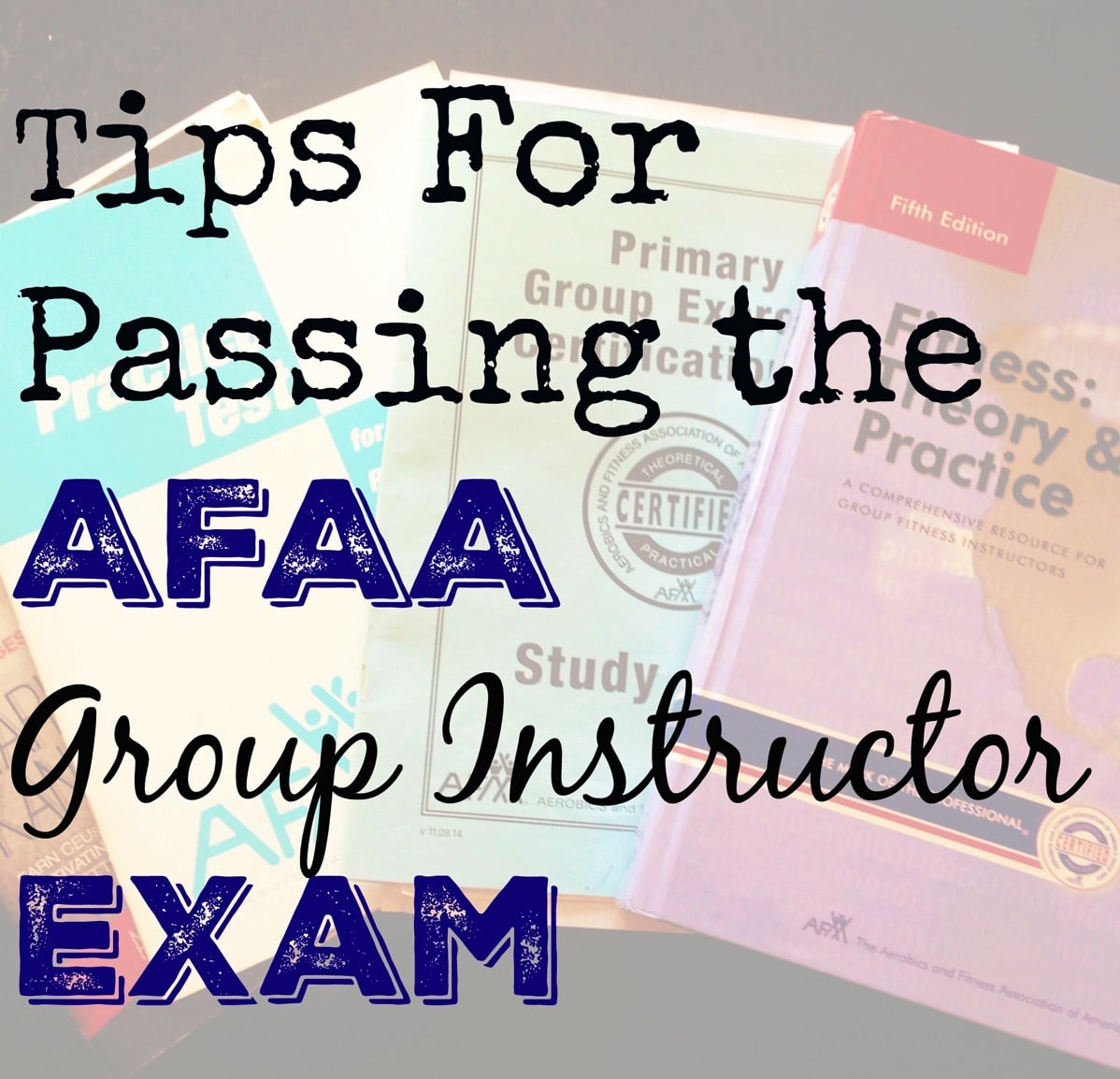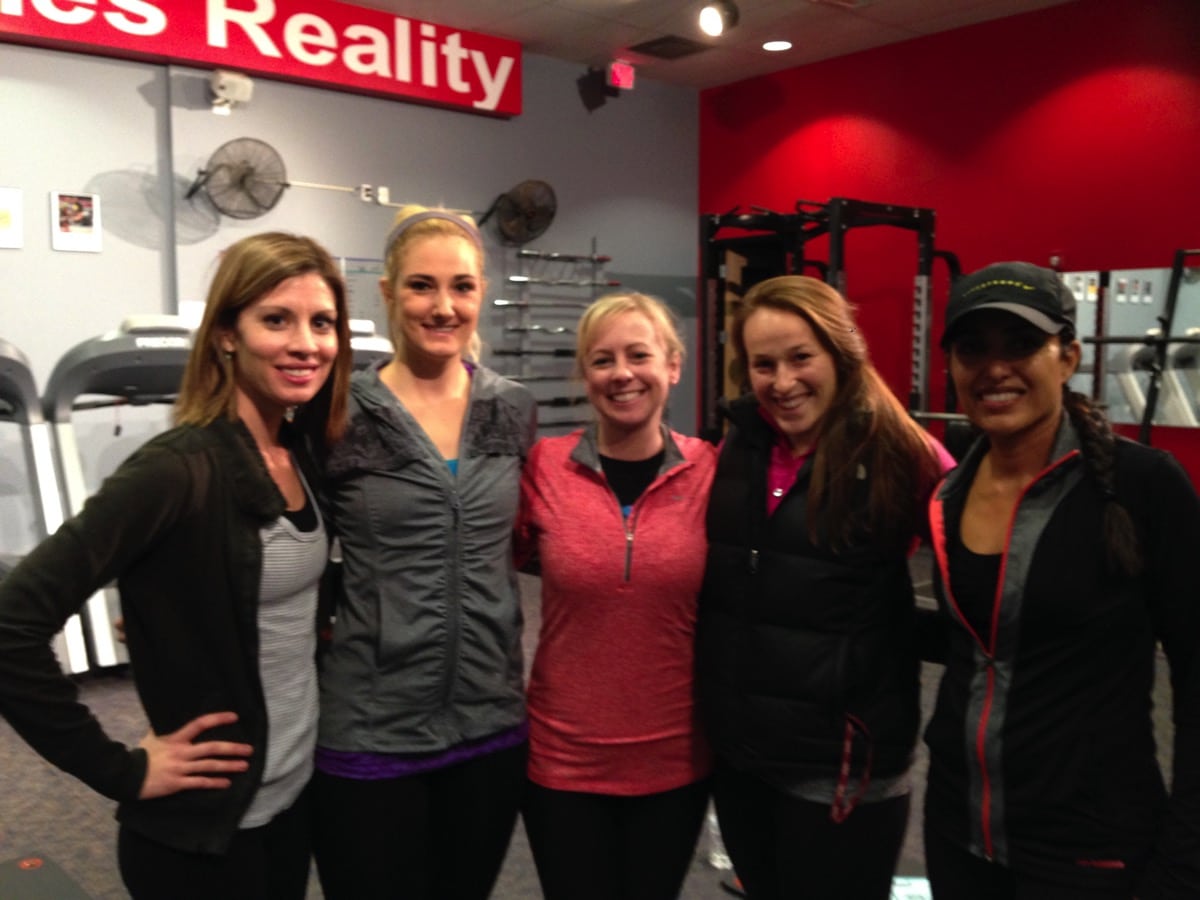Hi, Friends! I’ve been meaning to recap my AFAA group exercise certification but wanted to make sure I had passed before I announced it on the blog, you know, just in case. Earlier this got the news; I need to send in my CPR card, and I passed!
I figured we would do this Q&A Style so we could get to the main points!

How did you decide on AFAA, aren’t there many group fitness certifications?
- Yes, there are many group fitness certs, I chose AFAA for a few reasons.
- I asked my friend who is a Group Fitness Department Head at my old gym, and she recommended AFAA or ACE.
- I consulted google and found out that both AFAA and ACE are widely accepted.
- AFAA was cheaper and literally two blocks from my home.
- AFAA is partnering with NASM and would, therefore, count as a CE for my NASM CPT cert.
How Long Did You Study?
I bought the materials two months before the test date, once I looked through them I realized I knew a lot of that material from passing NASM last March. I ended up only studying a total of 10 days. (I thought I studied 2-3 weeks, but when I looked back in my notes I realized it was ten days, then I remembered all the cramming.) I took each section recommended to cover in 5 days and did it one day because I’m so over studying and taking tests. Not a good excuse I know, but it’s the truth. If you aren’t already a personal trainer or have a background in exercise science, I would recommend studying quite a bit more than that.
What Did You Study?
For the written portion:
I followed the recommended outline and filled out the study guide. Immediately after I finished the study guide I took the practice test, then I went back through the many areas that I missed. I think I got a 66% or something horrendous on the practice test, but then I knew what to study. About three days before the test I used flashcards (links below) to hammer in the points, I didn’t know. If I could change anything about the way I studied it would be to use the flashcards from the beginning, super helpful if you like to study with flash cards. I would probably still cram, though; I think ten days was plenty for me. A few key points:
- Know safety concerns of each format class and special populations—> spend a lot of time here!
- Know anatomy and physiology
- Know AFAA 5 Questions WORD FOR WORD
- know the high-risk exercises and how to modify them
For the practical:
There are three parts to the practical:
- Group Cardio: progressive warm up and regressive cooldown
- Group Muscle Strength/ Flexibility (2 exercise/1 stretch):
- Pectorals
- Trapezius, Rhomboids, latissimus dorsi
- deltoids
- biceps, triceps
- hip adductors, hip abductors,
- gluteus maximus
- quadriceps, tibialis anterior
- hamstrings, gastrocnemius, soleus
- rectus abdominal, obliques
- erector spine
- Individual Presentation
The primary way I studied for this was by reading a million blog posts (all listed below), and I planned to do what they did for their presentation (don’t fix what isn’t broken was my thought process.) A few key points:
- pick two light exercises and one stretch to demonstrate for each group avoiding HIGH-RISK exercise and stretch —> I practiced this with Mr. Hungry who got a great laugh out of it.
- Practice your exercise demonstration & individual presentation at home
- Practice your cardio warm up and cool down
What Was The Workshop/Testing Like?
The Morning
So many of my awesome blogging friends have written great detailed posts about what their workshop and experience was like, so I almost wasn’t going to recap my experience. However, when I showed up and found out there were only five people registered I knew I had to post about my knowledge because my experience was so very different from every single recap I read.
Our instructor was one of those instructors that teach other trainers and travels all over the U.S. to do so. He is a seasoned professional that has been teaching group fitness for decades and has an infinite amount of knowledge. While most other post recaps I read said the instructor did a great job at calming their fears about the demonstration portion of the test, our instructor kind of did the opposite. I think he wanted us to take it seriously and was afraid if he were too nice then we wouldn’t?
We spent the first half of the day reviewing the study guide. The instructor did a great job at emphasizing points we needed to know for the test. At that point, I realized that in typical Kelli test freak out mode, I way over studied. That realization was all right by me because that meant I could focus on the presentation section of the exam. Right before lunch we had time to practice our cardio warm up on our own and then as a group. However, we couldn’t figure out how to work the music, so we did it without music. That was SUPER weird and awkward, but we got through it.
During Lunch
I brought my lunch (a quest bar and UCAN just like the good old Life Time days—> I need to buy a new cooler/lunch box), but everyone else went out for lunch, so I went along with a new friend to Starbucks. With such a small group things seemed much laxer than other stories I had read about, so I just wasn’t very nervous, very weird for me since I am a usually crazy anxious nail biter when it comes to taking tests.
After Lunch—> The Practical Test
Most of the after lunch portion were spent addressing the practical part of the exam. We went over appropriate exercises for each muscle group and practiced our demonstration. So here is where things got interesting, I wrote down two options from other blogs that detailed what they had done and that they passed. Therefore, I wasn’t worried AT ALL about the demonstration because I had a passing set of exercise demonstrations with explanation and I felt confident in my form. I went with Jackie’s Plie Squat, which I felt super comfortable demonstrating—>
Plie Squat—-> Add Arms—> Pulsing Squat
We did a practice round for the instructor, and each of us got creamed. He wanted our exercises to not only PROGRESS upward but also REGRESS. He also didn’t agree that pulsing was an acceptable increase of intensity since you can’t regress a pulse. What I ended up doing—>
Plie Squat—> Add Arms —> Elevate on Toes
I made it a point to remind the “class” that they could drop their arms to make it easier and that they did not have to elevate if they didn’t want to. I can see why he was so adamant about it; it’s an important to know how to design a class with appropriate exercises that can be progressed/regressed easily. You never know what level of fitness you will have in any given class so you should be ultra prepared. However, I was still so taken back because I had done my research, I thought I knew exactly what I was doing! I wanted to switch to plan B, the crunch, but the instructor encouraged me to figure out a plan to make my original demonstration work. He reminded me that is what I would have to do in designing a real class. Touché!
After our practice round, we had a few minutes before the actual practical test. First, we did the muscle group exercise/stretch demonstration and then the individual presentation. After everyone was done, the instructor told us that our practice cardio round was sufficient to pass and that we had all just passed the practical! I think because we were a smaller group we ended up going a little slower do to all the questions we kept asking, so he figured there was no point in making us redo the cardio portion. In any case, that was fun to know I passed the practical since I was pretty confident in the written portion.
The Written Test
The exam was the very last thing of the day, and it took me about 20 minutes to complete. Since I was the first one done, I went back and checked all my answers again, so I ended up finishing in 30 minutes or so. I ended up getting 100%, so I guess ten days to study was good enough for me!
What Should You Bring To The Workshop?
- A #2 pencil—> I didn’t bring one and had to run around like a mad woman looking for one, just bring a pencil.
- your completed study guide
- your list of muscle group exercises, your plan for your cardio/ exercise demonstrations
- snacks and lunch
- wear workout clothes you will be moving a lot (even if there are only five people in your class)
- an open mind, I know it’s cheesy, but I had to be open-minded when my exercise demonstration plan was derailed
FINAL THOUGHTS
So now I passed! I wanted to become a group fitness instructor because when I was at Life Time, I LOVED LOVED LOVED my TEAM classes, by the end of my time there I was teaching three of them! I knew, even though I left the gym to teach and focus on Hungry Hobby Clients (RD & blog partners) I still really wanted to be involved in the fitness world (as more than just a sports dietitian). So now I’m pursuing places to teach at. I’ll also be attending the IDEA Blogfest this summer at which time I might look into obtaining a certification like spin or BodyPump. I think I’m currently most qualified to teach a strength training or boot camp class since I don’t know any choreography for other classes but I look forward to learning!
If you are reading this you are already doing a great job preparing, the best thing I did to prepare myself was read blog posts. When I got there, I knew exactly what to expect which helped calm my fears quite a bit. Plus, you can retake it if you fail a part, so it isn’t that big of a deal! I've linked the resources I used below, definitely, check them out if you plan on taking the test!
Fantastic RESOURCES:
- http://katywidrick.com/studied-took-passed-afaa-group-exercise-instructor-exam/
- http://thechiclife.com/2009/09/afaa-primary-certification-day.html
- http://www.nutritionnutontherun.com/2011/08/10/afaa-primary-group-exercise-certification-in-a-nutshell/#.Uc0WRo7D9Mt
- VERY DETAILED—>http://www.jackiedampfitness.com/?p=152
- http://www.pbfingers.com/2013/06/28/afaa-group-exercise-certification/
- FLASHCARDS: https://quizlet.com/13043957/afaa-primary-group-exercise-certification-study-guide-flash-cards/
- FLASHCARDS: http://www.flashcardmachine.com/flashcards/?topic_id=1401274
- FLASHCARDS: http://www.flashcardmachine.com/print/?limit_flagged=include&topic_id=1401274&mode=cut&cpp=3&size=4x6 (flashcards)
- YOUTUBE CARDIO VIDEOS:
- https://www.youtube.com/watch?v=Tri2iLq0L_o
- https://www.youtube.com/watch?v=q51KcgbuJIY








Nia says
Did you have to take the workshop or was it optional?
Kelli Shallal MPH RD says
I don't remember for 100% certain but I think it was required.